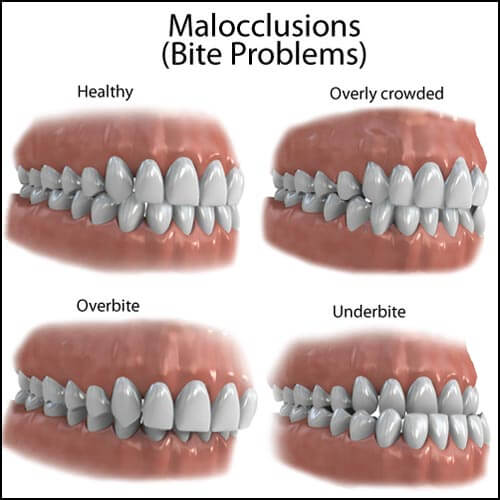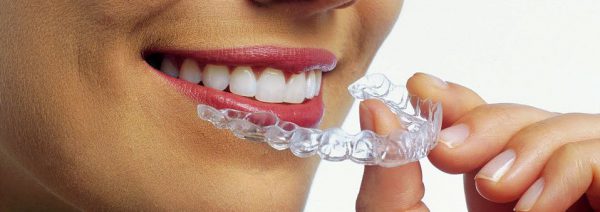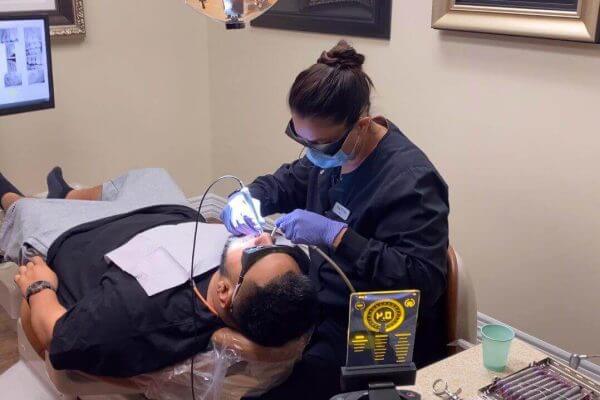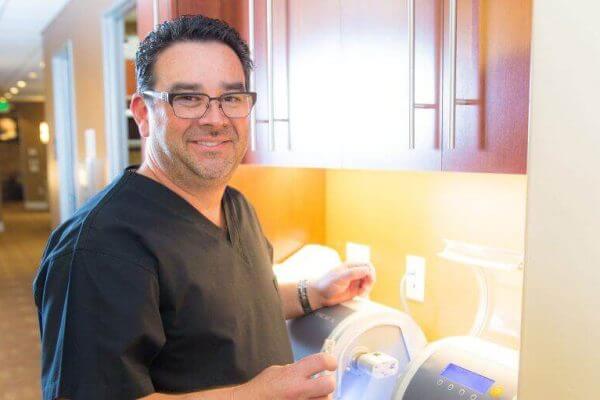Types of Bite Problems Treated with Invisalign
At Lakefront Family Dentistry, nestled in the serene landscape of Lake Elsinore, patients find more than just a beautiful private dental practice. It’s a place where advanced dental technology meets personalized care. It is a practice where smiles are not just treated, they are transformed. Led by Dr. Mark Phillipe and Dr. Derek Hauser, this dentist office offers a wide range of dental solutions, from routine check-ups to orthodontic treatments with Invisalign.
Dr. Mark Phillipe and Dr. Derek Hauser, the powerhouse behind Lakefront Family Dentistry, bring a combined experience of over 40 years in the field of dentistry. Their journey, spanning four decades, is marked by countless success stories of restored smiles and improved oral health. Serving the community of Southern California, the dentists’ expertise lies in diagnosing, treating, and preventing a range of dental conditions with the highest standard of care.
Technology. Convenience. Comfort.
In their constant endeavor to provide the best for their patients, Lakefront Family Dentistry offers Invisalign—an innovative solution to straightening teeth. Recognized for its efficiency, convenience, and near-invisibility, Invisalign stands as a testament to the practice’s commitment to providing advanced dental solutions. Invisalign is not just a treatment; it is a journey towards a perfect smile. Dr. Phillipe and Dr. Hauser guide their patients every step of the way, ensuring a comfortable and rewarding experience.
Stay with us as we delve into the fascinating world of Invisalign and explore how it can correct various types of bite problems, often referred to as malocclusions, and contribute to your oral health and overall well-being.

Understanding Bite Problems
Common Causes and Types of Malocclusions
Malocclusions, more commonly referred to as bite problems, occur when the alignment of the teeth or the arrangement of the jaw doesn’t fit together correctly. These misalignments can lead to oral health problems, discomfort, and impact the appearance of one’s smile.
Malocclusions can have various causes. They can be genetic, meaning you can inherit them from your parents, or they can be acquired. Common causes include:
- Genetic Factors: Many malocclusions are passed down genetically, such as the size of one’s jaw in relation to the size of their teeth. If the teeth are too large for the jaw, crowding can occur. On the other hand, if the teeth are too small, spacing issues can arise.
- Developmental Changes: Changes that occur during the development and growth of the teeth and jaw can also cause malocclusions. This includes factors such as prolonged thumb sucking, use of a pacifier beyond the age of three, or excessive use of a bottle during early childhood.
- Injury or Trauma: Injuries or trauma to the jaw can lead to malocclusions. This can occur from accidents, sports injuries, or any event causing a misalignment of the jaw.
- Tumors or Oral Health Conditions: Conditions affecting the mouth or jaw, such as tumors or oral health issues like gum disease, can also lead to malocclusions.
Types of Malocclusions
This is a short overview that lists the types of malocclusions, including:
- Overbite: This is when the upper front teeth overlap the lower front teeth more than is typical. In severe cases, the lower teeth may bite into the roof of the mouth.
- Underbite: This occurs when the lower teeth are further forward than the upper teeth. It often gives the chin a prominent appearance.
- Crossbite: A crossbite happens when the upper teeth do not come down slightly in front of the lower teeth as normal when biting down.
- Open Bite: An open bite is when there are spaces between the biting surfaces of the front and/or side teeth when the back teeth bite together.
- Misplaced Midline: This occurs when the center of your upper front teeth does not line up with the center of your lower front teeth.
- Spacing or Crowding Issues: These are self-explanatory and occur when there’s either too much or too little room for the teeth in the jaw, leading to gaps or overlapping teeth.
Understanding the cause and type of malocclusion is crucial in determining the most effective treatment plan. At Lakefront Family Dentistry, Dr. Mark Phillipe and Dr. Derek Hauser leverage their combined experience of 40 years to diagnose and treat these issues, often using innovative solutions like Invisalign to help patients achieve healthy and well-aligned smiles.

How Malocclusions Can Affect Oral Health and Overall Well-Being
Malocclusions, or bite problems, while often viewed as a cosmetic issue, can have far-reaching implications on both oral health and overall well-being. Here’s how:
- Oral Health Implications: Improper alignment of teeth can lead to a myriad of dental problems. For starters, malocclusions can cause excessive wear and tear on certain teeth, increasing the risk of tooth damage and loss over time. Furthermore, certain types of malocclusions, such as overcrowding, can make it difficult to brush and floss effectively, increasing the risk of cavities and periodontal disease. In severe cases, malocclusions can lead to temporomandibular joint (TMJ) disorders, causing pain in the jaw joint and the muscles controlling jaw movement.
- Speech and Eating Difficulties: Malocclusions can affect the function of the oral cavity, leading to challenges with speech and eating. Overbites, underbites, and crossbites may impact the way you articulate words, leading to speech issues. Similarly, misaligned teeth can interfere with the proper chewing and digestion of food.
- Psychological Impact: Beyond the physical impact, malocclusions can also affect a person’s self-esteem and confidence. A person’s smile plays a significant role in their self-image and social interactions. Living with misaligned teeth can make people feel self-conscious about their appearance, leading to reduced social interaction and negative impacts on mental health.
- Sleep Apnea: Certain types of malocclusions, like overbites, can increase the risk of developing sleep disorders such as sleep apnea. This condition is characterized by repeated interruptions in breathing during sleep, leading to poor sleep quality and various health risks if left untreated.
At Lakefront Family Dentistry, Dr. Mark Phillipe and Dr. Derek Hauser understand the broad impact that malocclusions can have on a patient’s life. Their comprehensive approach to dentistry involves not only treating the malocclusion itself but also addressing the associated risks and symptoms to improve patients’ overall quality of life. With treatments like Invisalign, they are committed to helping patients overcome the challenges posed by malocclusions, offering them the chance to enjoy healthy, beautiful smiles and the enhanced well-being that comes along with it.
Invisalign: An Overview
How Invisalign Works to Correct Malocclusions
Invisalign corrects malocclusions using an innovative approach that marries modern technology with the science of orthodontics. The process begins with a detailed examination and consultation with Dr. Mark Phillipe or Dr. Derek Hauser at Lakefront Family Dentistry. Once it’s determined that Invisalign is the right treatment option, the journey to a beautifully aligned smile begins.
- Digital Impression: The first step involves taking a precise 3D digital impression of your teeth using advanced imaging technology. This model serves as the blueprint for creating your personalized Invisalign treatment plan.
- Treatment Planning: Using the 3D model, Dr. Phillipe or Dr. Hauser then maps out the exact movements your teeth need to make to correct the malocclusion. This detailed treatment plan also predicts the progression of teeth movement throughout the treatment, offering a virtual representation of your transformation even before you start.
- Creating the Aligners: Once the treatment plan is ready, it’s sent to Invisalign labs where your custom aligners are created. These aligners are made from SmartTrack material, known for its comfort and clear appearance.
- Wearing the Aligners: Patients will wear each set of aligners for 20-22 hours a day, only removing them for eating, drinking, brushing, and flossing. Each aligner subtly shifts your teeth a little further towards their ideal position.
- Progress Tracking: Approximately every 1-2 weeks, you’ll switch to a new set of aligners, further progressing your treatment. Regular check-ins with Dr. Phillipe or Dr. Hauser at Lakefront Family Dentistry will ensure your treatment is going as planned, making any necessary adjustments for optimal results.
- Maintenance Post-Treatment: Once your teeth have reached their desired positions, you’ll likely need to wear retainers to maintain your new smile. Just like the aligners, these can be clear and discreet.
Invisalign has proven to be an effective solution for various types of malocclusions, including overbite, underbite, crossbite, and more. At Lakefront Family Dentistry, patients can trust that their Invisalign treatment is handled by experienced professionals, guiding them through each step of the process, and ensuring you achieve the smile of your dreams.

Benefits of Invisalign Over Traditional Braces
While traditional braces have been the standard for orthodontic treatment for many years, Invisalign offers several significant advantages that make it a popular choice for patients at Lakefront Family Dentistry.
- Aesthetics: Perhaps the most obvious advantage of Invisalign is its virtually invisible appearance. The clear aligners blend in with your teeth, making it almost undetectable to the casual observer. This makes Invisalign particularly popular among adults and teens who may feel self-conscious about wearing traditional metal braces.
- Comfort: Invisalign aligners are made from smooth, flexible plastic, making them more comfortable than metal braces, which can have sharp edges that irritate the gums and the insides of the mouth.
- Removability: Unlike traditional braces which are fixed to the teeth, Invisalign aligners are removable. This allows you to eat and drink what you like during treatment and maintain your regular oral hygiene routine of brushing and flossing without the need for special tools.
- Convenience: With Invisalign, fewer adjustments are necessary, meaning fewer trips to the dentist. The aligners are also less likely to experience a sudden breakage or discomfort that requires an emergency visit.
- Predictability: With 3D imaging technology, Dr. Mark Phillipe and Dr. Derek Hauser can create a detailed treatment plan that shows you what your final results will look like even before the treatment begins. This can be a significant motivator during the treatment process.
- Improved Oral Health: Since the aligners are removable, it’s easier to keep your teeth and gums clean and healthy during treatment. This reduces the risk of developing issues like tooth decay and gum disease.
Types of Bite Problems Invisalign Can Correct
If you are a suitable candidate, the doctors will take a 3D digital scan of your teeth and create a customized treatment plan using Invisalign’s advanced technology. This plan will illustrate the step-by-step transformation of your smile as your upper and lower teeth gradually align into their optimal positions.
Each set of custom-made aligners will apply gentle and consistent force to your teeth, moving the upper teeth back and/or the lower teeth forward to reduce the overbite. With regular wear, usually about 20-22 hours a day, and periodic check-ups at Lakefront Family Dentistry, your bite issue may be significantly improved or completely corrected.
Invisalign’s clear aligners offer a comfortable, virtually invisible way to correct malocclusions. The treatment not only results in a more balanced and attractive smile, but it also improves overall oral health by reducing the risk of tooth decay and gum disease caused by malocclusions. With Invisalign, patients at Lakefront Family Dentistry can look forward to achieving a healthier, straighter smile without the inconveniences of traditional orthodontic treatments.
Overbite: Explanation and How Invisalign Can Help
An overbite is a type of malocclusion characterized by the upper teeth significantly overlapping the lower teeth when the mouth is closed. This dental issue is not just a cosmetic concern; it can also lead to a variety of oral health problems, including gum irritation, wear on the lower teeth, jaw pain, and difficulty in chewing.
However, an overbite does not have to be a lifelong condition. Thanks to advancements in orthodontic technology, it can be effectively corrected using Invisalign.
Invisalign is a cutting-edge orthodontic system that utilizes a series of clear, custom-made aligners to gradually move your teeth into the desired position. These aligners are not only virtually invisible, but they’re also removable, giving patients the freedom to eat, drink, brush, and floss normally throughout their treatment.
In the case of an overbite, Invisalign works by applying controlled force to the teeth to slowly shift them into proper alignment. The treatment process is personalized to each patient based on a digital plan created by Dr. Phillipe and Dr. Hauser. Each set of aligners is worn for about one to two weeks, gradually moving the teeth, and correcting the overbite over time.
One of the biggest advantages of Invisalign is that it allows patients to see their treatment plan and the expected result even before starting the treatment, giving them a clear vision of their journey to a healthier and more aesthetically pleasing smile.
Underbite: Explanation and How Invisalign Can Help
An underbite is a type of malocclusion where the lower teeth protrude in front of the upper teeth when the mouth is closed. This condition is usually due to an overgrowth of the lower jaw, an undergrowth of the upper jaw, or a combination of both. Underbites can lead to problems such as difficulty chewing, speaking difficulties, and increased wear on the teeth.
Invisalign can help correct underbites in many cases, particularly when the issue is primarily related to tooth position rather than jawbone structure. The process of correcting an underbite with Invisalign is like that of other malocclusions.
Crossbite: Explanation and How Invisalign Can Help
A crossbite is a form of malocclusion where some of the upper teeth rest inside the lower teeth instead of on the outside, as they normally would. This misalignment can occur on one or both sides of the mouth and can affect a single tooth or several teeth. It can lead to various problems, including abnormal wear and tear on the teeth, gum disease, bone loss, and jaw problems.
With Invisalign, patients with crossbites can achieve a healthier, more balanced smile under the expert care of the team at Lakefront Family Dentistry.
Open Bite: Explanation and How Invisalign Can Help
An open bite is a type of malocclusion where the upper and lower front teeth do not touch when the mouth is closed, creating an opening or gap between them. This can lead to difficulties with chewing and biting, speech issues, and even oral discomfort. It can be caused by a variety of factors, such as prolonged thumb sucking, tongue thrusting, or genetic predisposition.
Invisalign has proven to be effective in treating many cases of open bite. The treatment process begins with a comprehensive examination by Dr. Mark Phillipe or Dr. Derek Hauser at Lakefront Family Dentistry to determine the severity of the open bite and whether Invisalign would be an appropriate treatment method.
Types of Bite Problems Invisalign Can Correct
Gapped Teeth: Explanation and How Invisalign Can Help
Gapped teeth, also known as diastema, refers to noticeable spaces between two or more of your teeth. These gaps can occur anywhere in the mouth but are mostly seen between the two upper front teeth. While often a cosmetic concern, gapped teeth can also sometimes contribute to oral health issues such as food trapping between the teeth leading to gum problems or tooth decay.
Invisalign is an effective solution for closing gaps between teeth. At Lakefront Family Dentistry, Dr. Mark Phillipe and Dr. Derek Hauser assess your dental structure and determine if Invisalign is the right course of action for your specific situation.
Crowded Teeth: Explanation and How Invisalign Can Help
Crowded teeth occur when there isn’t enough space in your mouth to accommodate all your teeth properly, causing them to overlap, twist, or get pushed into the wrong position. This issue can make teeth more difficult to clean effectively, increasing the risk of tooth decay and gum disease. It can also impact the appearance of your smile and your self-confidence.
Invisalign aligners are virtually invisible and can be removed when eating, drinking, brushing, and flossing. This not only makes the treatment process more comfortable and aesthetically pleasing, but it also enables you to maintain good oral hygiene throughout the treatment period.
Through the skilled use of Invisalign by Dr. Phillipe and Dr. Hauser, patients with crowded teeth can achieve a healthier and more balanced smile. The convenience, comfort, and effectiveness of Invisalign make it a preferred choice for many looking to correct crowded teeth without the discomfort and visibility of traditional braces.
The Consultation: What to Expect and How the Dentists Determine if Invisalign is the Right Course of Treatment
At Lakefront Family Dentistry, your journey to a healthier, straighter smile begins with a comprehensive Invisalign consultation. This is a crucial step in the process, as it is during this appointment that Dr. Mark Phillipe or Dr. Derek Hauser will determine if Invisalign is the right course of treatment for your unique dental needs.
The consultation begins with a warm welcome and introduction to the practice. Here, you can express your dental concerns and goals, which will guide the dentist in assessing your suitability for Invisalign treatment.
Next, the dentist will carry out a thorough oral examination. This includes evaluating the alignment of your teeth, the health of your gums, and the overall condition of your oral health. They may also take a series of dental x-rays or digital scans to gain a complete picture of your mouth’s structure, including your jawbone and underlying teeth roots.
Based on this detailed assessment, the dentist will then determine whether Invisalign is an appropriate solution for you. Factors that are considered include the type and severity of your malocclusion, your oral health status, and your personal preferences and lifestyle considerations.
For instance, if you have mild to moderate malocclusion, good oral health, and a desire for a discreet treatment option, Invisalign could be an excellent choice. However, more complex or severe cases of malocclusion may require a different approach.
Should Invisalign be the chosen treatment, the dentist will explain the process in detail, addressing any questions or concerns you may have. They will give you a clear understanding of what to expect throughout the treatment process, including the time commitment, cost, and expected outcomes.

By the end of your consultation at Lakefront Family Dentistry, you will have a comprehensive understanding of your dental health, whether Invisalign is right for you, and how the treatment can help you achieve a healthier, more beautiful smile.
Schedule Your Dental Consultation Appointment
If you suspect that you may have a malocclusion or are unhappy with the alignment of your teeth, there is a solution. Invisalign offers a discrete, comfortable, and effective treatment for a variety of dental alignment issues. Dr. Mark Phillipe and Dr. Derek Hauser are experienced in helping patients just like you to attain healthier, more confident smiles with Invisalign.
Why wait any longer to explore the potential of your smile? Take the first step towards a healthier, more confident you by scheduling a consultation with Lakefront Family Dentistry. You’ll receive a comprehensive oral examination, and if you’re a suitable candidate for Invisalign, we’ll guide you through every step of the process. Contact us today during business hours at (951) 244-9495 and let’s embark on this journey to a radiant smile together or fill out the Schedule a Dental Appointment form on our website any time of day or night.





